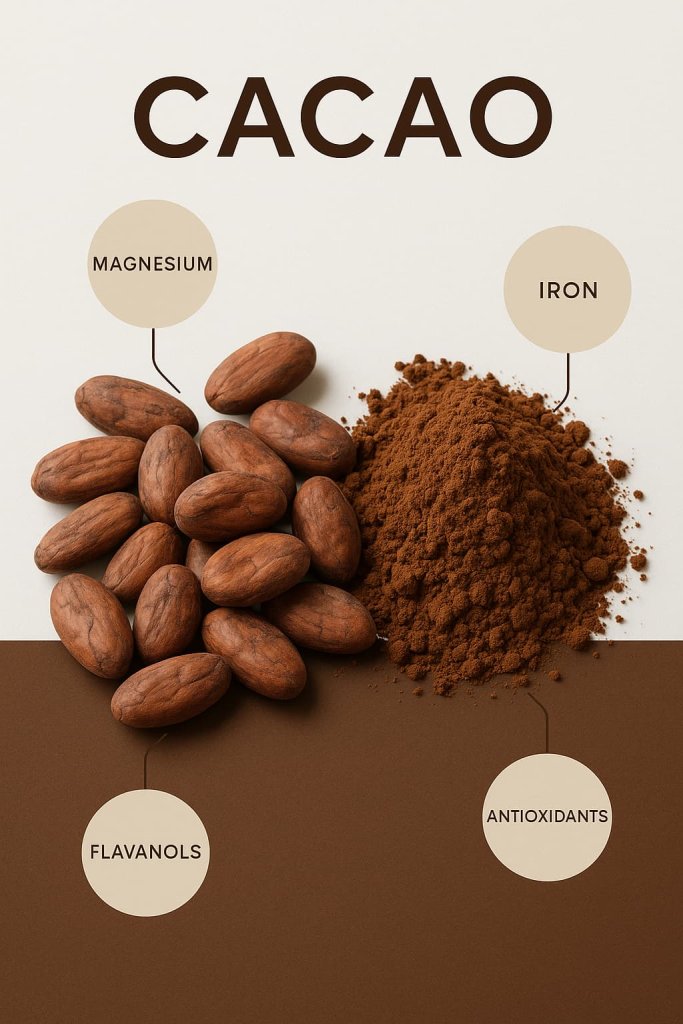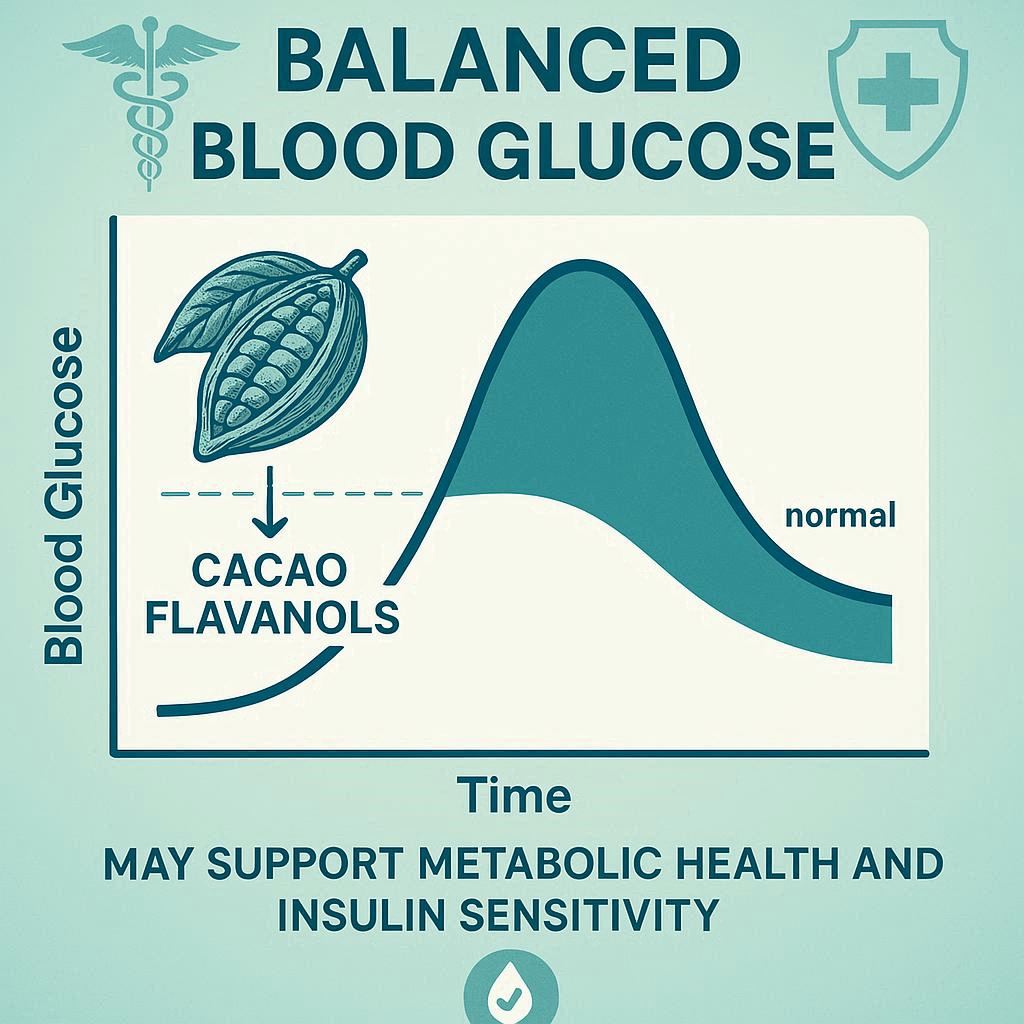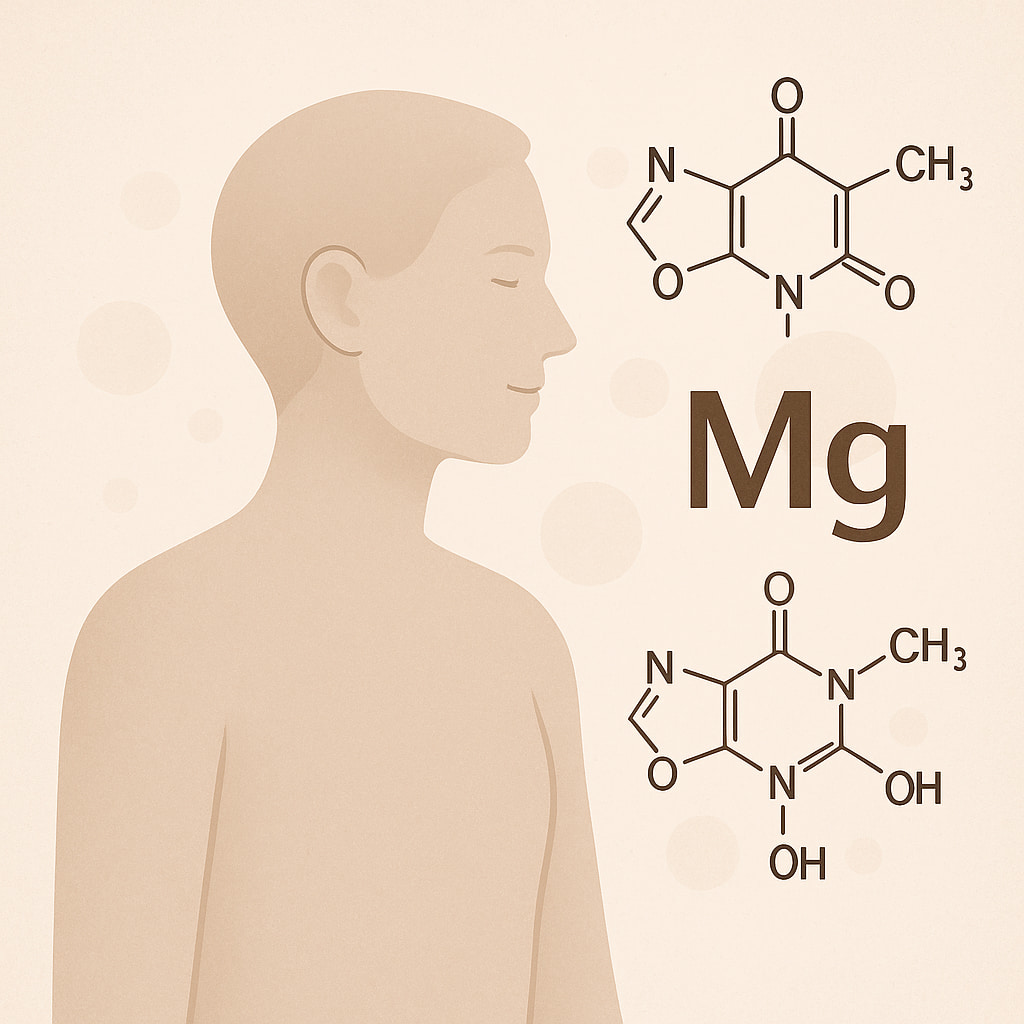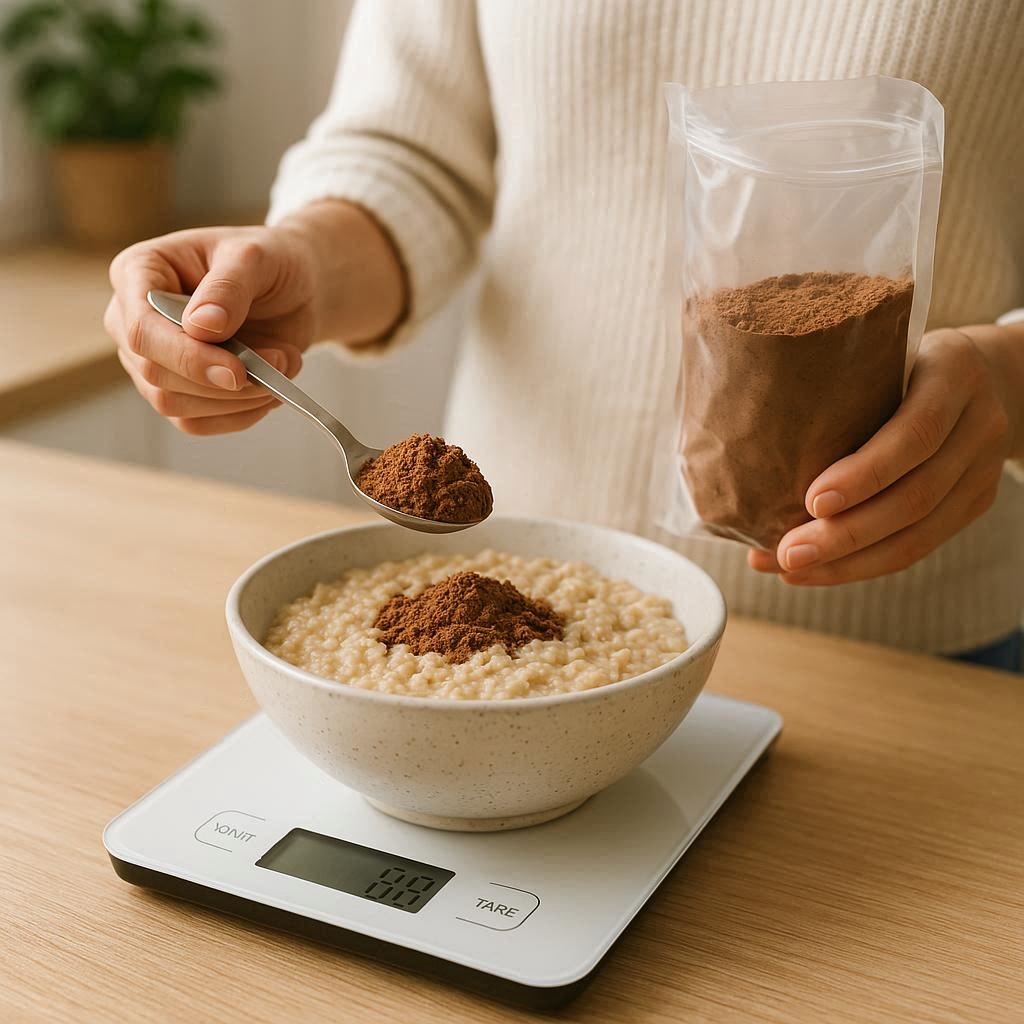Cacao may support heart health, brain function, and overall well-being thanks to its rich content of flavonoids, antioxidants, and essential minerals.
Understanding the benefits of cacao helps you make informed dietary choices—especially when selecting high-quality, minimally processed cacao or dark chocolate. Research continues to show that the bioactive compounds in cacao may promote cardiovascular, cognitive, and metabolic health while offering antioxidant protection.

What Is Cacao? (Overview and Nutrition Profile)
Cacao is the raw, minimally processed form of the cacao bean that serves as the foundation for chocolate and cocoa products. It comes from the Theobroma cacao tree, native to Central and South America, and is prized for its naturally high concentration of flavanols, antioxidants, and essential minerals.
Unlike cocoa powder, which is roasted at high temperatures and often mixed with sugar or milk solids, raw cacao is produced by cold-pressing unroasted cacao beans. This process preserves more of its heat-sensitive nutrients — especially magnesium, iron, and polyphenols — giving it superior nutritional value.

Cacao vs. Cocoa: Key Differences
| Feature | Cacao | Cocoa |
|---|---|---|
| Processing | Cold-pressed, minimally heated | Roasted and processed at higher heat |
| Nutrient Density | Retains more flavanols and antioxidants | Fewer active flavanols due to heat |
| Flavor | Earthy and slightly bitter | Smoother and sweeter |
| Common Uses | Smoothies, oatmeal, baking, dark chocolate, supplements | Hot cocoa, desserts, sweetened chocolate |
According to the BBC Good Food and the Harvard T.H. Chan School of Public Health, cacao provides bioactive compounds that support vascular, metabolic, and neurological health when consumed in moderation.
Nutritional Profile of Raw Cacao Powder (Per 100 g)
| Nutrient | Amount | % Daily Value | Source |
|---|---|---|---|
| Calories | 228 kcal | – | USDA FoodData Central |
| Protein | 19.6 g | 39 % | USDA |
| Fat | 13.7 g | 21 % | USDA |
| Carbohydrates | 57.9 g | 19 % | USDA |
| Dietary Fiber | 33.2 g | 118 % | USDA |
| Magnesium | 499 mg | 125 % | USDA |
| Iron | 13.9 mg | 77 % | USDA |
| Potassium | 1524 mg | 32 % | USDA |
| Zinc | 6.8 mg | 62 % | USDA |
These values highlight cacao’s dense nutrient profile, particularly its magnesium, iron, fiber, and antioxidant flavanols — compounds that support heart health, energy metabolism, and cellular protection.
Including raw or minimally processed cacao in a balanced diet offers a nutrient-rich way to support cardiovascular, neurological, and metabolic wellness — especially when used as an alternative to sugary cocoa-based treats.
10 Proven Health Benefits of Cacao (Backed by Science)
Cacao offers a broad range of science-backed health benefits due to its rich content of flavanols, antioxidants, and essential minerals. From cardiovascular and brain health to metabolic balance and mood support, its compounds contribute to overall wellness when consumed in moderation and in minimally processed forms.
1. Supports Heart and Cardiovascular Health

Cacao flavanols may support cardiovascular health by enhancing blood vessel flexibility, lowering blood pressure, and improving circulation. Research published in Frontiers in Nutrition (2022) found that high-flavanol cacao stimulates nitric oxide production, which helps relax blood vessels and maintain normal blood flow — a key factor in heart wellness.
In 2023, the U.S. Food and Drug Administration (FDA) issued a qualified health claim stating that cocoa flavanols in high-flavanol cocoa powder may help reduce the risk of cardiovascular disease, though the evidence remains limited. You can view the official statement on the FDA website.
Best practice: For optimal benefits, choose dark chocolate with at least 70% cacao or raw, unprocessed cacao powder free of added sugars and fats.
2. Provides Powerful Antioxidants

Raw cacao is one of the richest natural sources of antioxidants. Its flavanols and polyphenols may help neutralize free radicals, reduce oxidative stress, and support long-term cell health.
According to Harvard Health Publishing (2023), cocoa flavanols support blood vessel function and provide antioxidant protection that contributes to better cardiovascular and cellular health (Harvard Health).
Including antioxidant-rich foods such as cacao in your diet can support your body’s natural defense against oxidative damage linked to aging and chronic inflammation.
3. May Enhance Brain Function and Mood

Cacao contains compounds such as flavanols, theobromine, and phenylethylamine, which may support mental clarity, memory, and emotional well-being.
A review from Harvard Medical School (2022) reported that cocoa flavanols improve blood flow to the brain, supporting cognitive performance and attention (Harvard Health Blog).
Additionally, cacao naturally promotes the production of serotonin and endorphins, which are associated with improved mood and relaxation. Enjoying a small serving of pure cacao can be an uplifting and beneficial daily ritual.
4. Supports Healthy Blood Pressure

Regular consumption of high-flavanol cacao may help maintain healthy blood pressure levels. Flavanols promote nitric oxide synthesis, improving vascular elasticity and reducing arterial stiffness.
Clinical studies published in The American Journal of Clinical Nutrition demonstrate that cocoa flavanols may improve endothelial function and support healthy blood pressure, especially in individuals with mild hypertension.
To maximize this effect, opt for unsweetened cacao powder rather than processed chocolate, which can contain high levels of sugar and saturated fat.
5. May Support Metabolic Health and Insulin Sensitivity

Cacao’s natural compounds may help improve insulin sensitivity and support healthy glucose metabolism.
A 2021 systematic review in Nutrients found that moderate cocoa consumption was associated with lower fasting glucose and improved lipid profiles, suggesting a beneficial impact on metabolic health.
However, product quality matters — look for unsweetened cacao or high-flavanol dark chocolate rather than sugar-laden candy bars. A small serving of raw cacao in smoothies or oatmeal can be a smart metabolic addition.
6. Promotes Gut Health and Microbiome Balance

Cacao is naturally high in fiber and prebiotic polyphenols, which can nourish beneficial gut bacteria and support digestive health.
Research in Frontiers in Microbiology (2020) found that cacao polyphenols encourage the growth of Lactobacillus and Bifidobacterium species, both of which are linked to healthy digestion and immune function.
Adding a teaspoon of cacao to yogurt or smoothies may gently support gut microbiome diversity and digestive wellness.
7. May Improve Skin Appearance and Protection

Flavanol-rich cacao may help protect the skin from oxidative stress and ultraviolet (UV) damage while improving hydration and elasticity.
A 2023 Journal of Nutrition study observed that participants who consumed high-flavanol cocoa for 12 weeks experienced improved skin texture, hydration, and blood flow.
By supporting collagen integrity and microcirculation, cacao can complement topical skincare routines — though it should be viewed as a dietary ally, not a replacement for sunscreen or professional skincare.
8. Supports Mental Well-Being and Stress Reduction

Cacao’s natural compounds — theobromine, magnesium, and anandamide — may promote relaxation and support mental balance.
According to the NIH Office of Dietary Supplements, magnesium plays an essential role in nervous system regulation and mood stability. Cacao is one of the richest natural plant sources of magnesium, making it beneficial for stress resilience.
Enjoying a warm cacao beverage in the evening can be a soothing, caffeine-light way to unwind while supporting mental wellness.
9. Provides Essential Minerals for Bone and Cellular Health

Cacao is an excellent source of magnesium, iron, and potassium, all of which are crucial for bone integrity, red blood cell production, and muscle function.
According to the U.S. Department of Agriculture (USDA) FoodData Central, 100 g of unsweetened cacao powder provides approximately 499 mg of magnesium (125% DV), 13.9 mg of iron (77% DV), and 1524 mg of potassium (32% DV).
These minerals support cellular energy production, nerve transmission, and overall physiological balance — key components of long-term wellness.
10. May Support Weight and Appetite Regulation

Cacao’s high fiber and flavanol content may help promote satiety and moderate appetite.
Studies indicate that cocoa polyphenols may influence gut hormones such as ghrelin and leptin, which regulate hunger and fullness signals.
When consumed in its pure form — without excess sugars or fats — cacao can be a satisfying addition to a balanced diet, supporting healthy weight maintenance as part of a mindful eating routine.
How to Add Cacao to Your Diet

Cacao can be a versatile and nutrient-dense addition to your daily diet when used in moderation. Because it’s rich in flavanols, magnesium, and antioxidants, small amounts may support wellness without excess calories or caffeine.
Healthy Ways to Enjoy Cacao
- Smoothies: Add 1 tablespoon of raw cacao powder to smoothies with banana, spinach, or nut milk for a nutrient-rich boost.
- Oatmeal or Yogurt: Sprinkle cacao nibs or powder over breakfast bowls for added fiber and flavor.
- Dark Chocolate: Choose high-quality dark chocolate (at least 70% cacao) with minimal sugar and no hydrogenated oils.
- Baking and Snacks: Use cacao powder in homemade energy balls, protein bars, or baked goods as a wholesome alternative to sweetened cocoa.
- Pair with Fruits and Nuts: Combining cacao with vitamin C–rich fruits (like strawberries or oranges) may enhance iron absorption and improve flavor balance.
Both Harvard Health Publishing and BBC Good Food recommend incorporating cacao into a balanced diet in moderation (1–2 tablespoons per day) to maximize benefits while minimizing caffeine intake and calorie load.
Possible Side Effects and Precautions
While cacao is generally considered safe for most healthy adults when consumed in moderation, it contains naturally occurring compounds such as caffeine, theobromine, and phenylethylamine, which may affect sensitive individuals. Understanding potential side effects allows you to enjoy cacao responsibly and align with safe, evidence-based dietary practices.
Potential Concerns
| Concern | Details | Source |
|---|---|---|
| Caffeine and Theobromine Sensitivity | Cacao naturally contains caffeine and theobromine, both mild stimulants that may cause restlessness, rapid heartbeat, or difficulty sleeping in caffeine-sensitive individuals—especially when consumed late in the day. Limiting intake to morning or early afternoon can minimize these effects. | MedlinePlus – Caffeine |
| Migraine Triggers | Some migraine-prone individuals report that foods containing caffeine, tyramine, or phenylethylamine—like cacao and chocolate—may trigger headaches. Although research remains mixed, it’s best to monitor your individual tolerance. | American Migraine Foundation – Diet and Headache Control |
| Allergic Reactions | Food allergies to cacao are rare but possible. Symptoms may include skin irritation, gastrointestinal upset, or mild respiratory discomfort. Those with known food allergies should read product labels carefully. | AAAAI – Food Allergy Overview |
| Medication Interactions | Individuals taking stimulant medications, MAO inhibitors, or antidepressants should consult their healthcare provider before consuming large quantities of cacao. Compounds like theobromine and caffeine can interact with certain medications, enhancing stimulant effects. | NIH Office of Dietary Supplements – Fact Sheets |
Summary: Cacao is generally well tolerated when enjoyed in small amounts (1–2 tablespoons per day). However, people who are sensitive to caffeine, have a history of migraines, or take certain prescription medications should approach it cautiously and seek medical guidance if unsure.
Storage and Food Safety Tips
Proper storage ensures that cacao retains its flavor, nutrient quality, and antioxidant potency. Improper handling may lead to oxidation, clumping, or mold growth in humid conditions.
Safe Storage Guidelines
Proper storage is essential to maintain cacao’s nutritional quality, antioxidant potency, and natural flavor. Because cacao is sensitive to heat, humidity, and light, following safe storage practices ensures that it stays fresh and free from microbial or oxidative damage.
Safe Storage Guidelines
- Temperature:
Store cacao products in a cool, dry place below 25 °C (77 °F) and away from direct sunlight or heat sources. High temperatures can cause cacao butter to separate, resulting in a “bloom” (white film) that affects texture but not safety. - Container:
Use airtight glass jars or resealable food-grade bags to prevent exposure to moisture, odors, and air. Proper sealing helps preserve the flavor and polyphenol content of cacao powder and nibs. - Shelf Life:
- Raw cacao powder: retains peak freshness for 12–18 months if kept sealed and dry.
- Cacao nibs: can stay fresh for up to two years under similar storage conditions.
Always check expiration dates and store in smaller, tightly closed batches if opened frequently.
- Avoid Contamination:
Always use a clean, dry spoon when scooping cacao to prevent introducing moisture or bacteria. Avoid touching with wet utensils or hands, as this can accelerate spoilage. - Freezing or Refrigeration:
For longer storage, refrigerate or freeze cacao in an airtight, moisture-proof container. Before opening, allow the container to reach room temperature to avoid condensation inside.
For comprehensive guidance on home food storage safety, refer to the USDA Nutrition.gov – Safe Food Storage Guidelines, which outline best practices for preserving the quality and safety of dry, plant-based foods such as cacao.
Following these evidence-based storage practices ensures your cacao remains safe, flavorful, and nutritionally potent, maintaining its antioxidants, minerals, and overall wellness benefits.
Frequently Asked Questions (FAQ)
1. Is raw cacao healthier than cocoa powder?
Yes. Raw cacao is less processed and retains more flavanols, antioxidants, and minerals compared to roasted cocoa powder.
2. How much cacao is safe daily?
Most health experts recommend 1–2 tablespoons (10–20 g) per day, as larger amounts can contribute to caffeine overload or digestive sensitivity.
3. Does cacao contain caffeine?
Yes, cacao contains about 20–40 mg of caffeine per tablespoon, depending on the variety and processing.
4. Can cacao support mood naturally?
Cacao may support mood balance by increasing serotonin and endorphin production, but it’s not a medical treatment for depression or anxiety.
5. Is cacao safe for people with diabetes?
Unsweetened cacao may support metabolic health due to its low sugar and high polyphenol content, but products with added sugar should be avoided.
6. What’s the difference between cacao nibs and powder?
Cacao nibs are crushed raw cacao beans containing healthy fats and fiber, while cacao powder is a ground and defatted version with a stronger flavor and higher antioxidant density.
Conclusion
Cacao is a nutrient-dense, flavanol-rich food that supports heart, brain, and metabolic wellness when enjoyed in moderation. Its antioxidants, minerals, and natural compounds offer multiple health benefits, making it a valuable addition to a balanced diet — especially when replacing sugary chocolate products.
Always prioritize high-quality, minimally processed cacao, and combine it with whole foods like fruits, nuts, and grains for best results.
This content is for informational purposes only and not medical advice.
References:
